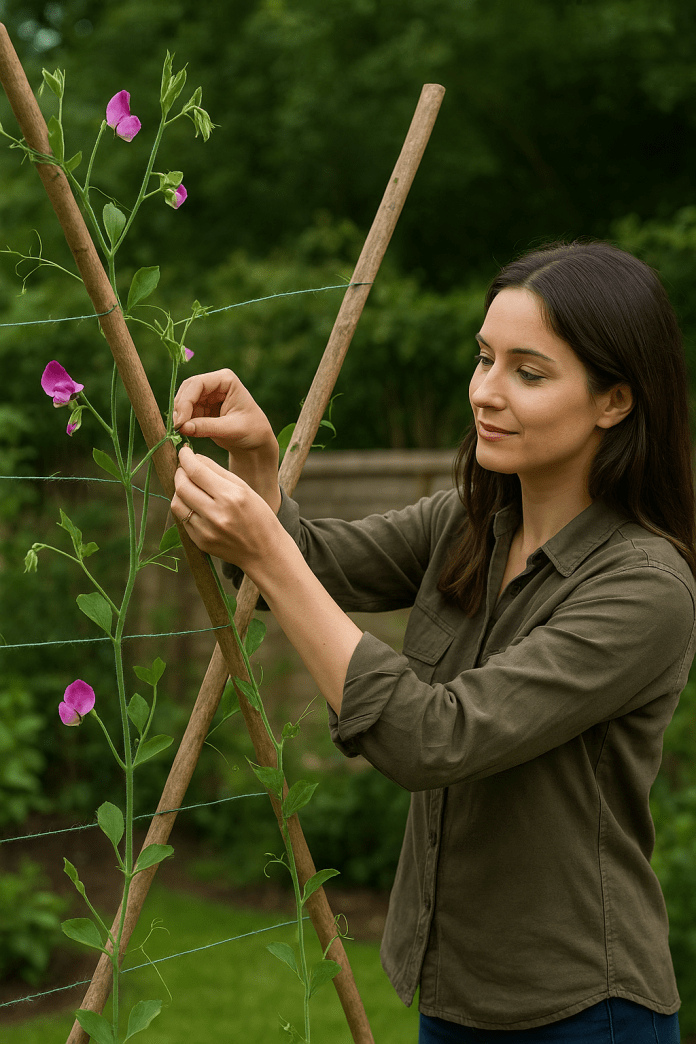Sweet Peas in May: Tie In, Feed, and Get Ready for Blooms
Sweet peas are a classic cottage garden favourite, loved for their delicate fragrance and romantic, fluttery blooms. If you’ve raised them from seed, May is the time to give them a helping hand as they stretch towards summer flowering.
Whether you’ve sown them in autumn or early spring, May is when sweet peas need your attention—for support, feeding, and a bit of training.
1. Planting Out
If your sweet peas have been grown under cover, harden them off over a week or two by placing them outside during the day and bringing them in at night. Once they’ve adjusted, they’re ready for the open ground.
Plant them in rich, moisture-retentive soil in a sunny position. They like cool roots and warm tops—so mulch the base to conserve moisture and keep roots shaded.
Spacing: About 15–20cm apart at the base of a support such as canes, netting, obelisks, or trellis.
2. Choose the Right Support Shape
While wigwams and obelisks are popular, the best support for sweet peas—especially if you want strong, straight stems and plenty of blooms—is a fan-shaped or V-shaped trellis that flares outward at the top.
✅ Why a flared or fan trellis is better:
- More light and air reach every stem
- Longer, straighter flower stems for cutting or showing
- Easier to train each vine individually, reducing tangling
Many experienced growers avoid wigwams because they cause stems to crowd and twist at the top, leading to shorter and misshapen blooms. A fan-shaped structure—like angled canes or a panel trellis fixed to a fence—is ideal for spreading out the stems as they climb.
3. Tie In Regularly
Sweet peas are natural climbers but need guidance. In May, their long, delicate tendrils begin to twine and wander.
- Tie them in loosely with twine or soft plant ties every 20–30cm up the support.
- Remove excess tendrils if you’re growing for long stems—they can pull other shoots off course.
- Check every few days and re-tie as needed.
4. Pinch Out for Bushier Growth
If you didn’t pinch out your sweet peas earlier, it’s still worth doing for any smaller plants in early May. Pinching out the top pair of leaves encourages side shoots, which means more flowers later.
5. Water and Feed
Keep the soil evenly moist. A good soak once or twice a week in dry weather is better than daily trickles. Mulching helps retain moisture.
Once plants are established, start feeding with a high-potash liquid feed every week or two to encourage flower bud formation.
6. Watch for Pests
Slugs, snails, and aphids all enjoy sweet peas—especially young plants. Use wildlife-friendly slug deterrents and check regularly for pests on growing tips.
At a Glance: May Sweet Pea Tasks
- Harden off and plant out seedlings
- Tie in stems to supports every few days
- Use a fan or V-shaped support for best results
- Water regularly and mulch the base
- Begin liquid feeding when established
- Check for slugs, snails, and aphids
With a good support structure and a little weekly care, your sweet peas will reward you with masses of beautiful, fragrant flowers all summer long.




